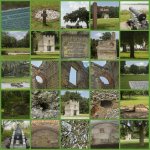Frederica
The name was feminized to distinguish it from Fort Frederick in South Carolina. About 630 British troops were stationed at the fort.
- A town of up to 500 colonial residents had grown up outside the fort.
- It was laid out following principles of the Oglethorpe Plan for towns in the Georgia Colony.
- The town was named Frederica, after Frederick, Prince of Wales, son of King George II.
- Fort Frederica National Monument
- The town survived a fire in 1758, but after a few more years, it was abandoned.
- Naturalist William Bartram visited the site in March, 1774.
- Though it was in ruins he noted that there was still a small garrison there.
The State Capital
- Concern over the Spanish forces at St. Augustine in Florida led Oglethorpe to return to England and plead for a British military presence south of Savannah.
- In 1736 Oglethorpe returned to Georgia with the regiment and additional colonists, with whom he established a new settlement on St. Simons Island. Here, they laid out the town of Frederica and built Fort Frederica on the island banks of the inland waterway.
- Oglethorpe spent the rest of his time in Georgia at Frederica, leading some historians to credit Frederica as Georgia's de facto capital from 1736 to 1743, when Oglethorpe returned to England.
The Beginning


As far as I understand, the below 19th means February 19th, 1735.
That had to be the best and last beer in the world, right?
Isn't it some amazing story?
Welcome to paradise! Only... did they really have enough people in this brand new colony to enjoy this paradise?
Only this paradise still sounds like a labor camp. The below pertains to 1736.
You are more than welcome to read the entire story, which is the source of the above excerpts. There are some interesting details in there. As the story goes, our Frederica was not meant to be.
Remains of good Tabby Walls... who here knows what tabby concrete is? I sure did not.
- Tabby is a type of concrete made by burning oyster shells to create lime, then mixing it with water, sand, ash and broken oyster shells.
- Tabby was used by early Spanish settlers in present-day North Carolina and Florida, then by British colonists primarily in coastal South Carolina and Georgia.
- Revivals in the use of tabby spread northward and continued into the early 19th century. Tabby was normally protected with a coating of plaster or stucco.
- Tabby's origin is uncertain. There is evidence that North African Moors brought a predecessor form of tabby to Spain when they invaded that kingdom.
- Tabby concrete - Wikipedia
What happens when the 19th century arrived. Well, we do not really know, but circumstantial evidence suggests that something had to.
And that was it for Frederica.
Older Plans and Maps
1740
We are being told that the entire Frederica set up looked like this.
To me, it looks like something snatched a good chunk of this star shaped city, like it was bit off or something. The entire engineering solution of building a star sounds suspicious, especially when we consider their population numbers.
- I also doubt that these are the structures we used to have in there.
KD: Isn't it interesting that between 1736 and 1758 they could afford to build and abandon a town? What was the colonial population at the time?
Them playing musical chairs with capitals also deserves some attention. With Savannah appearing to be the most prominent city, it had to also be the best protected and equipped one. Why would they make any other city or town a capital?
Additionally, I noticed that the oldest towns of the future state of Georgia are the ones that appear to turn into the so-called "ghost towns". Why?
So... what did this Frederica really look like, and what was there before Oglethorpe arrived?


